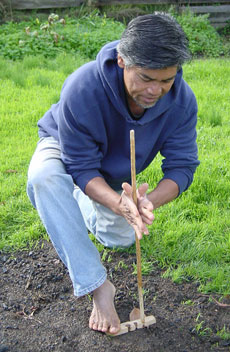
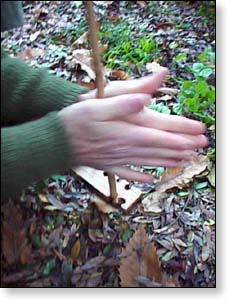


Spindle rotation and downward pressure are two of the most important requirements for starting a hand drill fire. To guide beginners, who are first learning to do a hand drill fire, a leather thong with thumb loops can help apply the downward pressure that is necessary for creating the needed friction.
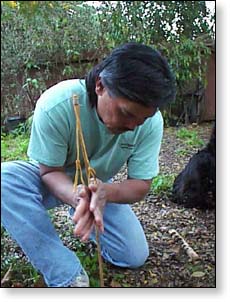
After you get the feel of the downward pressure by using the thong, try using the hand drill without the leather thong. Practice and patience will eventually improve your rate of success.
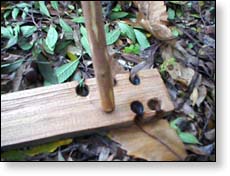
There are a variety of ways in preparing your notches. The notch in the photo above was cut tangent to the circle of the spindle hole on the hearthboard. Two V-shaped notches were cut on the top and bottom of the hearthboard for catching the char dust.
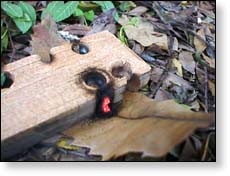
When you begin to see smoke coming from the spindle and hearthboard,
don't think that you have a fire and stop spinning the hand drill.
Be sure that the char dust has ignited before you stop rotating
the spindle.
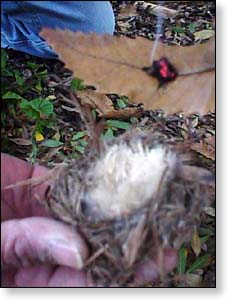
A leaf was placed under the hearthboard to catch the ignited char dust. The glowing ember was dropped into the cattail down in the tinder bundle. The bundle was constructed of the bast fibers of cottonwood and a pile of cattail down placed in the middle.
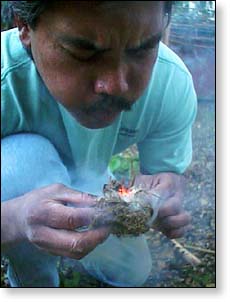
Blow into the cattail down to help extend the ignited char. Once the coal starts to spread, it helps to hold the tinder bundle out and above your head to keep the smoke from getting into your eyes.
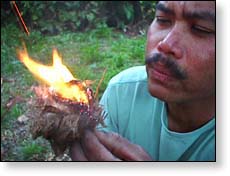
Continue blowing into the tinder bundle until it ignites into a flame.
The spindle was Mare's Tail (Conyza canadensis) and the hearthboard was Incense Cedar (Libocedrus decurrens). Other alternatives for the spindle are Mule Fat (Baccharis salicifolia), Blue Elderberry (Sambuca mexicana), or California Buckeye (Aesculus californica). Willow (Salix sp.) root and Red Cedar (Thuja plicata) are also good for hearthboards.
E-mail your comments to "Dino Labiste" at KahikoArts@yahoo.com
E-mail questions answered
about fire-by-friction.
We hope the information on the PrimitiveWays website is both instructional and enjoyable. Understand that no warranty or guarantee is included. We expect adults to act responsibly and children to be supervised by a responsible adult. If you use the information on this site to create your own projects or if you try techniques described on PrimitiveWays, behave in accordance with applicable laws, and think about the sustainability of natural resources. Using tools or techniques described on PrimitiveWays can be dangerous with exposure to heavy, sharp or pointed objects, fire, stone tools and hazards present in outdoor settings. Without proper care and caution, or if done incorrectly, there is a risk of property damage, personal injury or even death. So, be advised: Anyone using any information provided on the PrimitiveWays website assumes responsibility for using proper care and caution to protect property, the life, health and safety of himself or herself and all others. He or she expressly assumes all risk of harm or damage to all persons or property proximately caused by the use of this information.
© PrimitiveWays 2013